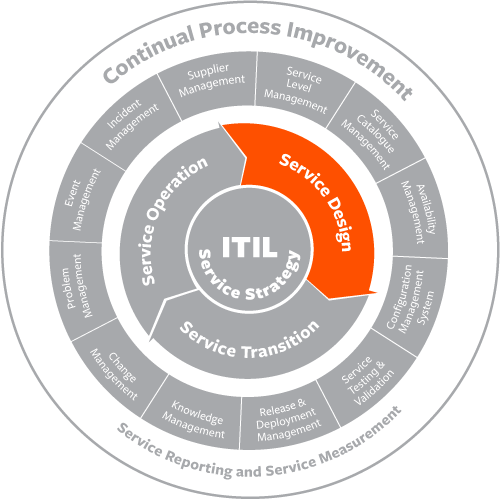Management Information System And Tools Aspects Of Service Design

ITIL 4 Guide ›
(This article is part of our ITIL v3 Guide. Use the right-hand menu to navigate.)
What is service design?
Service Design covers the fundamentals of designing services and processes.

It provides a holistic design approach to help an organization deliver better services. The five key aspects of service design are:
- Designing the service solution
- Management information systems and tools
- Technology
- Processes
- Measurements and metrics
Approach all aspects with service oriented thinking and decision making.
Download Now: ITIL 4 Best Practice e-Books
These all-new for 2020 ITIL e-books highlight important elements of ITIL 4 best practices. Quickly understand key changes and actionable concepts, written by ITIL 4 contributors.

Designing a service to meet an organization's strategic and customer needs requires coordination and collaboration. Aim for high service maturity when designing services rather than the completion of an IT project. The higher the service maturity the higher customer and user satisfaction will be.
Video: ITIL Service Design Capabilities
This video addresses capabilities needed for effectively consuming, designing and building services and systems. Relationship to service strategy, customer service focus, demand management, cloud computing and business intelligence to enable organization collaborative design capabilities are discussed. (11:46)
div class="bg-transparent center-block">
Service level management
The service level management (SLM) process focuses on researching and understanding requirements. Areas include:
- Defining, negotiating, agreeing upon and documenting IT service targets
- Monitoring, measuring and reporting on how well the service provider delivered the agreed upon targets
When targets are appropriate and met, then the business and IT have a better chance of becoming aligned.
Agreed upon targets are often spelled out in service level agreements (SLAs). Monitoring, measuring and reporting on SLA's in this way provides close links to Continual Service Improvement (CSI).
SLAs are agreements to provide specific services at a defined level of quality (warranty) for a specific price. SLAs typically need negotiation of agreements with other internal organizations (OLA's) or external suppliers (Underpinning Contracts).
Negotiating SLAs to ensure service commitments are met, service level management works with the following warranty processes:
- capacity management
- availability management
- security management
- service continuity management
Service level management is accountable for monitoring conformance to the SLAs and take action if there is a breach of the SLA. This means working with the service desk, incident management, and problem management.
Customer satisfaction is not determined only by SLA performance. Therefore service level management should meet with customers face-to-face on a regular basis. This helps to maintain a positive relationship address any concerns the customer may have.
Service catalog management
Service catalog management ensures that an accurate and up-to-date service catalog is available to all parties authorized to see it. All parts of IT Service Management, as well as customers and users, use the service catalog. Accuracy and availability are essential.
Service catalog management must work closely with service portfolio management as new services move from the pipeline into the catalog and older services are retired. It also helps define how services can be requested and what options are available (gold/silver levels, for instance). The service catalog should document all defined services.
The service catalog generally comprises two views:
- a business service view that is visible to the customer
- a technical service view that is visible only to IT personnel.
This enables the customer to choose services based on their business requirements. At the same IT personnel can use their view to determine what technical services they need to support a given business service.
Remedy IT Service Catalog: Free Trial

BMC provides ITIL®-compliant service catalog management solutions that help you improve user satisfaction, streamline service management, and increase opportunities for self-service automation.
Learn More › Free Trial ›
Capacity management
ITIL Capacity Management Processes & Best Practices ›
Availability management
Availability management ensures that infrastructure, tools, roles etc. are appropriate for the agreed targets. It also works with the design teams to ensure that availability is designed into services.
Part of the process is to identify vital business functions (VBFs) which IT services support. This will help clarify which approach to availability to take:
- prevention (making sure, as far as possible, that unavailability never happens)
- recovery (developing plans to restore service rapidly in the event of an outage).
Availability management views availability from the user's perspective, from end to end. This means identifying single points of failure and designing resilience into any infrastructure supporting the service. Availability management serves as a focal point for all issues in IT Service Management related to availability.
Availability management handles specifying which metrics to use to measure availability. And, monitors availability to ensure that the SLA targets are met.
IT service continuity management
IT service continuity management (ITSCM) focuses on supporting the overall continuity of the business. We define ITSCM as the process responsible for managing risks that could seriously impact IT services.
Risks so serious they could threaten the very survival of the business.
This activity is often referred to as disaster recovery (DR). But, the use of the term ITSCM should show that there is a corresponding business continuity management (BCM) process. ITSCM supports the BCM process.
ITSCM must work closely with BCM to perform risk analysis and business impact analysis (BIA). This analysis determines how different types of disruptions impact the business. The business areas determined to suffer the greatest impact need the most focus from the service continuity teams.
ITSCM is responsible for development and deployment of the service continuity plan. This includes regular testing and training of all personnel associated with the plan. ITSCM also works with change management to ensure that continuity plans are updated as the operational model changes.
There are four stages in the ITSCM lifecycle process:
- Initiation
- Requirements and strategy
- Implementation
- Ongoing operation

ITIL Information security management
ITIL Information Security Management Processes & Best Practices ›
Supplier management
Supplier management works with third parties, such as suppliers, to negotiate contracts for products or services. Supplier management monitor conformance to the contract conditions and address any breaches. At renewal, supplier management will determine whether to renew, renegotiate, or end the contract.
The objectives of supplier management is to ensure alignment of contracts with the needs of the business. It is also responsible for ensuring suppliers are meeting their commitments. The supplier and contract management information system (SCMIS) holds supplier and contract details.
Design coordination
The central principles in design coordination are balance, prioritization and integration with project management. Balance and prioritization address the utility and warranty of a service, as well as the needs of the service throughout its lifecycle.
Design coordination oversees all activity in the service design phase of the service lifecycle. Its aim is to ensure that a holistic, integrated approach is taken to the design of services. This is necessary because of the variety of disciplines involved in Service Design and the need to take a consistent approach.
Design coordination is accountable for the production of the service design package (SDP). The SDP is a comprehensive description of how a new or changed service is to be designed, built, tested, deployed, and operated. The SDP is the handoff from the Service Design phase to the Service Transition phase.
Design coordination handles managing resources needed by the Service Design phase of the lifecycle. This includes:
- Planning to ensure that adequate resources are available
- Scheduling access to resources among the many projects that may be in this phase at any one time
It is accountable for the performance and improvement of the Service Design phase of the lifecycle.
Video: ITIL Service Design Management
This video focuses on managing the development of a service product. Design coordination, cloud computing, other best practices are discussed as a component of an overall service management framework. (08:50)
div class="bg-transparent center-block">
ITIL 4 Best Practice e-Books
These all-new ITIL e-Books highlight important elements of ITIL 4 best practices so that you can quickly understand key changes and actionable concepts. Download now for free!

See an error or have a suggestion? Please let us know by emailing blogs@bmc.com.
BMC Bring the A-Game
From core to cloud to edge, BMC delivers the software and services that enable nearly 10,000 global customers, including 84% of the Forbes Global 100, to thrive in their ongoing evolution to an Autonomous Digital Enterprise.
Learn more about BMC ›
You may also like
About the author
![]()
BMC Software
BMC delivers software, services, and expertise to help more than 10,000 customers, including 84% of the Forbes Global 100, meet escalating digital demands and maximize IT innovation. From mainframe to mobile to multi-cloud and beyond, our solutions empower enterprises of every size and industry to run and reinvent their businesses with efficiency, security, and momentum for the future.
Management Information System And Tools Aspects Of Service Design
Source: https://www.bmc.com/blogs/itil-service-design/
Posted by: davissurprood1941.blogspot.com

0 Response to "Management Information System And Tools Aspects Of Service Design"
Post a Comment